|
Gail Wight ~ California
(Salt Point Press)
|
Share this page: |
|
|
Gail Wight works in experimental media focusing on issues of biology, the history of scientific theory and technology. She is currently Associate Professor at Stanford University Department of Art and Art History and Director of Graduate Studies in Studio Art and Experimental Media Arts.
Press statement: “Salt Point Press is the imprint of Gail Wight. These handmade books focus on the resilient yet precarious flora and fauna that live at the edge of the Pacific Ocean in the southern territories of the Pacific Northwest.. They explore hybrid practices combining new mediums and technologies with the traditional craft of bookbinding.” |
| |
|
Kingdom Aqueous
By Gail Wight
San Francisco, California: Salt Point Press, 2024. Edition of 24.
7.25” x 5” x 1”; 104 pages comprised of 12 double gatefolds and 1 concertina foldout. Twelve folios, each an eight-page gatefold. Full-bleed archival pigment prints on Hiromi asuka papers. Separate eight-page concertina fold with the colophon. Concertina bound in a hardcover of dubletta and asuka with gilded edges. Signed and numbered by the artist.
Gail Wight: "Photographed in the tide pools at Salt Point State Park in northern California over a period of twelve years, ‘Kingdom Aqueous’ is an ode to the creatures who live in this wild interstitial zone at the brink of the sixth mass extinction. Printed full bleed, these images disclose the intense vibrancy and other-worldly architecture of life beneath these cold and stormy northern waters. "
Colophon: “The form of the book is based on Kikuji Kawata’s book ‘Chizu’ (‘The Map’; 1965), with its rhythmic gatefolds and immersive photographic abstraction. As with ‘Chizu’, ‘Kingdom Aqueous’ pays homage to an apocalypse and alludes to an abstract terror while focusing on the beauty that survives catastrophe and destruction.”
$750 |
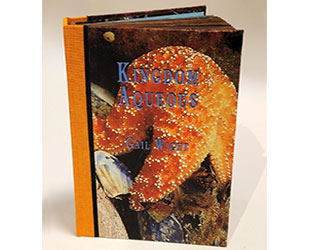
Click image for more |
| |
|
| |
|
Ostracod Rising
By Gail Wight
San Francisco, California: Salt Point Press, 2024. Edition of 26.
21.75” x 16.25” x 1”; 26 pages. Archival pigment prints on Hiromi asuka papers. Text is in Broadway and Cochin. Accordion bound with printed washi. Housed in a portfolio with inner wrapper. Portfolio bound in Asahi bookcloth, and lined with lokta. Wrapper Hiromi asuka with drawings of single-celled organisms. Conceived, created, and bound by G. Wight.
Gail Wight: "’Ostracod Rising’ tells the story of Earth’s past from 104 million years in the future. Beginning with the formation of Earth in the Hadean Eon, each page factually describes a distinct period of time throughout the ages. It then moves from our current Holocene into an imaginary yet highly plausible future consisting of the Anthropocene, Benthoscene, Silerecene, and finally the Ostracocene.
“Each page’s timeline covers the emergence and extinction of species, changes in atmosphere and climate, geologic and oceanic events, and the occasional asteroid collision. Large watercolor images of small creatures dominate each page, alongside other elements including day length, atmospheric content, continental drift, and the distance to our slowly receding moon.”
$3,000 |
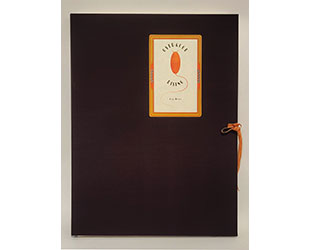
Click image for more |
| |
|
| |
|
Copepodilia Collectanea
By Gail Wight
San Francisco, California: Salt Point Press, 2022. Edition of 20.
5.5 x 7” closed, extends to 10 meter (64”); 80 pages. Accordion structure. Letterpress printed in Cochin. With illustrated paper wrapper. Archival pigment prints are on Canson Infinity Aquarelle. Letterpress pages at the beginning and end of the book are printed on Rives BFK with mulberry hinges. Housed in 8 x 8.25 x 3.25” clamshell box constructed of archival book board covered with pigment prints on Moenkopi kozo. Signed and numbered by the artist. Each box contains a unique piece of seaweed from the Pacific coastline in northern California.
Salt Point Press: “’Copepodilia Collectanea’ presents an imaginary menagerie of copepods – minuscule aquatic crustaceans – created using seaweed pressings. High resolution pigment prints of the pressings retain the textures and dimensionality of the original pressings.
“Text by Melanie Stiassny, ichthyologist at the American Museum of Natural History, introduces the fundamentals of copepod life.”
Copepods are important group of aquatic crustaceans. Over thirteen thousand species have been described and at least ten thousand of these live in the oceans, where they are found in every conceivable habitat, from the surface waters to the deepest abyss.
Gail Wight: “While reading Melanie Stiassny’s gorgeous book Opulent Oceans, I came to the chapter titled ‘ The Golden age of Copepodology’ and my mind was set ablaze. … With just a few facts in hand – they have little swimmy appendages for movement, sometimes egg sacs, and often tiny antennae – I decided to draw my own imaginary menagerie of copepods, using seaweed as my medium.”
$1,800 |
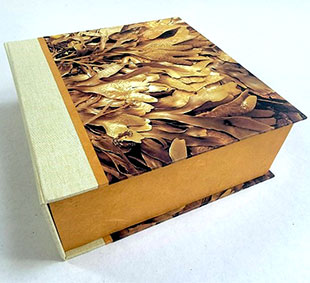 Click image for more
Click image for more |
| |
|
| |
|
Hexapodarium
By Gail Wight
In conversation with Lawrence Weschler
With essays by Iain Boal & Meredith Tromble
San Francisco, California: Salt Point Press, 2022. Edition of 1000.
10 x 8.25 “; 120 pages. Offset printing. Smyth bound, headbands, gilding. Debossed cloth hardcover. In illustrated paper wrapper.
Press statement: “What might houseflies, who evolved 65 million years ago, look like 65 million years in the future? Wight created a series of prints in 2014 in which flies have evolved to mimic familiar flowers: daisies, calla lilies, tulips and astors.
“Now, all sixty-four original prints have been gathered together in this gorgeous herbarium designed by Michelle Frey. With essays by Iain Boal and Meredith Tromble, this herbarium contains many additional photos, a conversation between Lawrence Weschler and Gail Wight, a Latin dictionary of flower names, and four full-bleed spreads of Wight’s work Land of the Flies.
“Filled with beautiful and detailed floral specimens, ‘Hexapodarium’ echoes the great botanical collections of previous centuries. Yet these flowers are otherworldly, constructed entirely from wings of ordinary house flies. They were created using composite photography of high resolution microscopic images of flies that expired in the artist’s studio during a particularly hot summer. Each flower alludes to a true plant species, reflected in its Latin binomial: part flower, part fly. In turn, Hexapodarium’s flowers become the palette for ‘Land of the Flies’. These frieze-like futuristic landscapes are built from hundreds of composited layers of flowers, flies, and other interloping flora and fauna.
“Three authors weigh in on ‘Hexapodarium’. Lawrence Weschler, New Yorker columnist and author of ‘Seeing is Forgetting the Name of the Thing One Sees’ and ‘True to Life: Twenty Five Years of Conversation with David Hockney’, engages Wight in a conversation traversing Darwin’s voyages on the Beagle, Dutch vanitas paintings, and the making of Hexapodarium.
“Iain Boal, social historian of technics and the commons and co-author of ‘Resisting the Virtual Life and Afflicted Powers’, sees ‘Hexapodarium’ as an art for the anthropocene, where we relinquish our hold on the future and engage in celebrating those creatures surrounding us who have survived multiple epochs and hold the promise of evolutionary wiles.
“Meredith Tromble ties it all together, placing Hexapodarium in the larger scope of Wight’s works of art. For decades, Wight has focused on life forms other than our own. Evolution, cognition, the animal-state-of-being, and deep time have been a source of biological allegory for Wight’s playful and provocative creations.”
$45 |
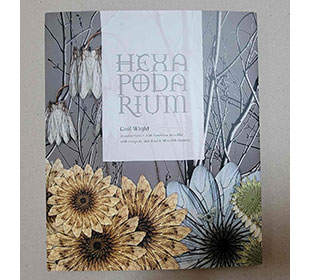
Click image for more
|
| |
|
| |
|
Restless Dust Postcards
By Gail Wight
San Francisco, California: San Francisco Center for the Book, 2010. Edition of 100.
6 x 4” a set of 4 postcards and sheet of stamps. Postcards separated by perforation. Letterpress and pigments prints. Signed and numbered by the artist. In cellophane envelope.
Gail Wight: “’Restless Dust Postcards’ is the accompanying trade edition of ‘Restless Dust’. It includes an accordion-fold set of four postcards separated by perforation. The postcards are letterpress and the sheet of stamps are archival pigment prints. Text and images come from the ‘Restless Dust’ book. The text of the book invites Charles Darwin’s ghost to sail to present day San Francisco and wander with me through the greater Bay Area. The focus of the journey is three-fold: to celebrate Northern California’s unique species; to examine Darwin’s legacy and its impact on the Bay Area; and to acknowledge the fragile and endangered state of local flora and fauna, beleaguered by environmental degradation during Darwin’s time and my own. Created while in residence with the Imprint at the San Francisco Center for the Book.
“The title is a remix of a quote from Mary Wollstonecraft: ‘It appears to me impossible that I should cease to exist, or that this active, restless spirit, equally alive to joy and sorrow, should be only organized dust.’”
$60 |

Click image for more |
| |
|
|
| Gail Wight SOLD / Out of Print Titles: |
|
| |
|
Restless Dust
By Gail Wight
San Francisco, California: San Francisco Center for the Book, 2009.
Edition of 50.
7.75 x 9.75 x 3.5" custom wooden box containing one book, two paper birds, velvet, and electronics. Book: 6.5 x 8.25", 36 pages. Linocut and pigment prints. Handset in Cheltenham Old Style. Printed on Rives heavyweight paper. Letterpress printed on a Vandercook press. Sewn binding in leather wrapper with leather tie closure.
Gail Wight: “’Restless Dust’ is a multimedia work housed in a two-tiered wooden box. The top portion holds a letterpress leather-bound artist’s book separated by Plexiglas from a velvet-lined chamber containing two illuminated paper birds (activated when the box lid is opened). The text invites Charles Darwin’s ghost to sail to present day San Francisco and wander with me through the greater Bay Area. The focus of the journey is three-fold: to celebrate Northern California’s unique species; to examine Darwin’s legacy and its impact on the Bay Area; and to acknowledge the fragile and endangered state of local flora and fauna, beleaguered by environmental degradation during Darwin’s time and my own. The book was created while in residence with the Imprint at the San Francisco Center for the Book.
“The title is a remix of a quote from Mary Wollstonecraft: ‘It appears to me impossible that I should cease to exist, or that this active, restless spirit, equally alive to joy and sorrow, should be only organized dust.’”
Anita Mohan, “Embodying Experience: A Conversation with Artist Gail Wight” (May 24, 2011): “Wight’s medium tends to be experimental media, I first became acquainted with her through her playful, more traditional artist’s book, ‘Restless Dust’. … The book was the direct result of Wight’s residency at the San Francisco Center for the Book … She had never made a book before — as with the rest of her work, the depth of her curiosity drove her to learn how.
“’Restless Dust’ takes as a point of departure an invitation to Darwin: What would you show Darwin if he visited the Bay Area? The idea came to Wight as she was driving around, listening to Otis Redding’s ‘(Sittin’ on) The Dock of the Bay’ — I want to meet Darwin at the bay and walk around with him. Uncertain of what to write, Wight sent an email to 30 artists, scientists or theorists of some kind, who shared an interest in Darwin, asking them, ‘If you could show Darwin one thing around the Bay Area — what would you show him?’
“The resulting book was a conversation between art and science, full of allusions and wordplay that looks at our culture and our endangered environment. At one point, for example, Wight plays with the double meaning of The Red Queen Effect. In Lewis Carroll’s ‘Through the Looking-Glass’, the Red Queen said, ‘It takes all the running you can do, to keep in the same place.’ A biologist coined the term ‘The Red Queen Effect’ from Carroll’s book to describe the need for any species to continue evolving in order to keep control of its space and keep up with the system within which it is striving to survive. The same sort of linguistic and visual whimsy occurs in asking how Darwin would solve the local problem of an invasive species of crabs that flow into the Bay Area and decimate local species. In a poetic turn, she writes that they would be pushed to sea in eucalyptus canoes; eucalyptus is also an invasive non-native species that crowds out native species, even killing local foraging birds with a suffocating tar-like substance.”
(SOLD/Out of Print) |
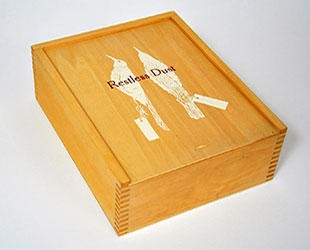
Click image for more
|
| |
|
| |
|
Page last update: 03.20.2025
|
